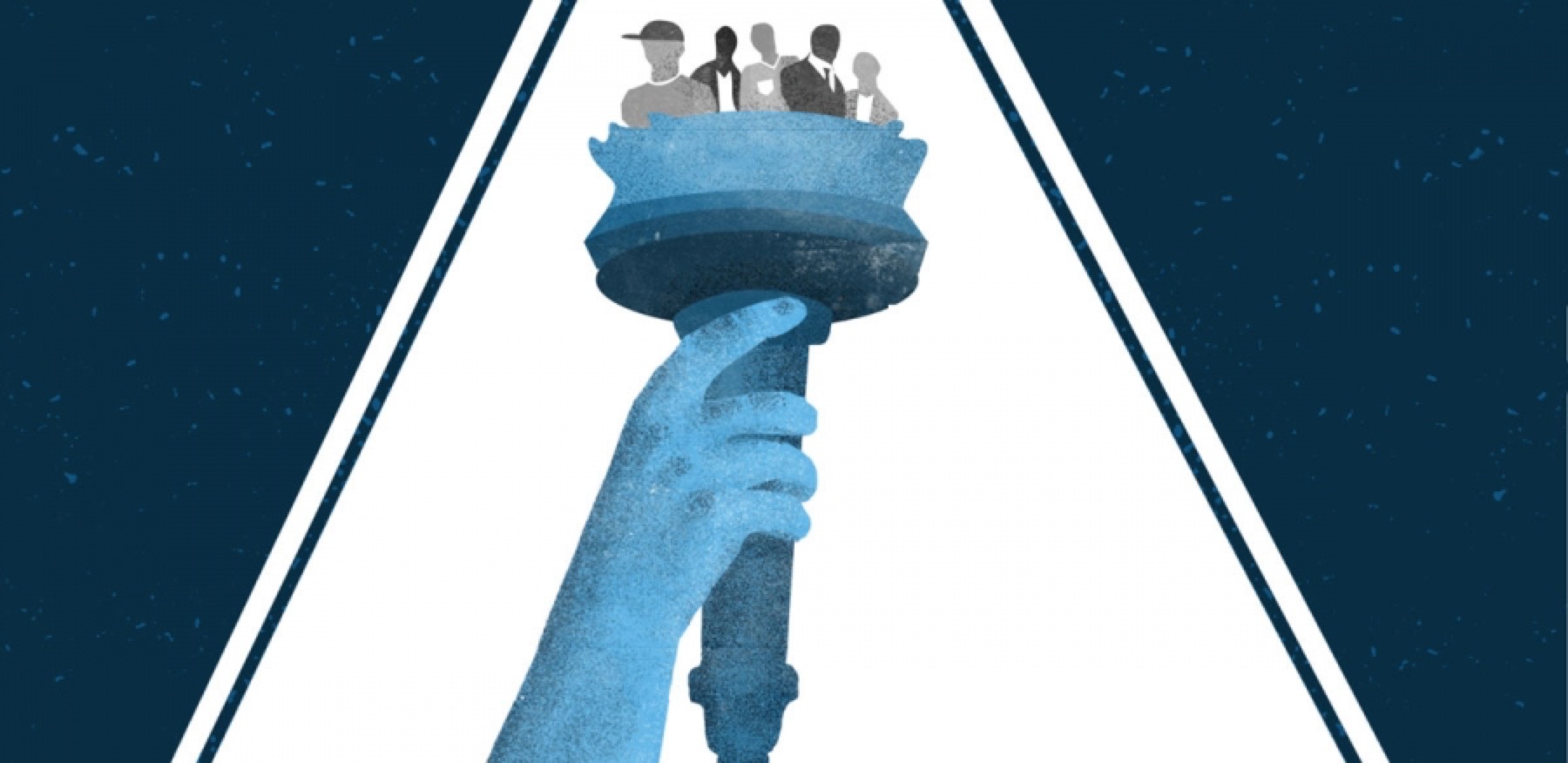
Torch graphic by Harper Biewen for MEN, Season 3 of the Scene on Radio podcast from the Center for Documentary Studies
MEN
By John Biewen
A Dispatch from the Center for Documentary Studies at Duke University
In 2017, I produced and hosted a fourteen-part series called Seeing White for the Center for Documentary Studies’ audio documentary podcast, Scene on Radio. The series drew a response beyond my imagining—well over a million downloads and a Peabody Award nomination. Featuring my collaborator Chenjerai Kumanyika, a media scholar at Rutgers, and a number of other experts, Seeing White looked at race in a couple of unusual ways: First, as I wrote in this space, the series turned the lens on whiteness and white people, in contrast to the typical practice of reporting on race through the experiences of people of color. Second, Seeing White went beyond the latest headlines about individual racist acts or remarks and instead took a frontal look at racism as a system, a framework built into American society from its beginnings to advantage those of us labeled “white.” We asked questions like, How did we get whiteness, blackness, and white supremacy in the first place? Who invented this system, and when, and why, and how has white dominance evolved with the times?
More than a few listeners responded to Seeing White by suggesting that for our next season, Scene on Radio take a similar look at gender issues: sexism, misogyny, patriarchy. (Yes, every one of those listeners was a woman.) With a couple other ideas already in the mix, I was intrigued but not convinced. By the time I really needed to decide about the 2018 season, though, #MeToo had exploded. That settled it. I spent the next six months reading, researching, and talking with leading scholars on gender—historians, sociologists, anthropologists—and our Season 3 series, MEN, launched last month.
Again, we’ve taken on a theme that’s all too timely and pervasive, one that encompasses far more than #MeToo and the drumbeat of revelations about sexual harassment in American workplaces. Add to that the fact that violent, deadly crimes are committed overwhelmingly by men, in every society on the planet. And the fact that around the world men still hold way more than our share of the political and economic power. Oh, and there’s that man in the White House who is not only an avid practitioner of white identity politics but also a persistent misogynist. At least judging from my social media feeds, more and more women are making their voices heard about male dominance, from the wage gap to sexual harassment to violence to mansplaining and -spreading.
In the early episodes of MEN, co-host Celeste Headlee and I dive into history and science to explore questions like, How and when did men seize for themselves the top spot in the gender hierarchy? (Spoiler: It happened long after “cave man” days.) How did the patriarchy survive Enlightenment ideas about universal human rights? What is gender, anyway, and what does the latest research say about the old nature-nurture question—that is, are the differences that we think we see in male and female humans partly biological or are those differences entirely socially constructed and learned?
I’m privileged to collaborate with Celeste, a veteran public radio journalist, author, and public speaker, as my guest co-host and conversationalist for the season. In Seeing White, Chenjerai Kumanyika brought an African American perspective to the project and helped to catch my blind spots as a white guy looking at whiteness; as a woman, Celeste is serving a similar role in MEN, and as a mixed-race woman she brings crucial insights as we tell stories that explore the many intersections between gender and race oppression.
Our most recent episode, for example, “Feminism in Black and White,” journeys through the nineteenth and twentieth centuries to look at the entanglements between racism and sexism and between the movements to fight those oppressive systems. Sojourner Truth’s “Ain’t I a Woman?” speech in 1851, the nation’s only successful coup in Wilmington, North Carolina, in 1898, the Montgomery bus boycott of 1955–56, the 2016 election and the Women’s March—in all these events and more, we find that “even though we try to peel [racism and sexism] apart,” as Celeste puts it, “you just can’t.”
The more privileged among us, especially white American men, are skilled in failing to even see these forms of oppression that benefit us. (And which simultaneously damage us in ways we also fail to see.)
I’m grateful for the opportunity to continue learning to see these waters that we all swim in, with the help of brilliant and insightful people like Celeste Headlee and the experts I’ve been able to interview, and to weave those findings into a sonic experience to share with Scene on Radio listeners. I’ll say it again: Come on along.
Find out more at sceneonradio.org. All episodes are available on the website or on your favorite podcast app, including the Seeing White series from Season 2 and MEN, the series-in-progress from Season 3 (episodes post biweekly). Scene on Radio is a production of the Center for Documentary Studies at Duke University distributed by PRX.
This installment of The By and By is curated by the Center for Documentary Studies at Duke University (CDS). CDS is dedicated to documentary expression and its role in creating a more just society. A nonprofit affiliate of Duke University, CDS teaches, produces, and presents the documentary arts across a full range of media—photography, audio, film, writing, experimental and new media—for students and audiences of all ages. CDS is renowned for innovative undergraduate, graduate, and continuing education classes; the Full Frame Documentary Film Festival; curated exhibitions; international prizes; award-winning books; radio programs and a podcast; and groundbreaking projects. For more information, visit the CDS website.
Enjoy this story? Read more at The By and By and subscribe to the Oxford American.


